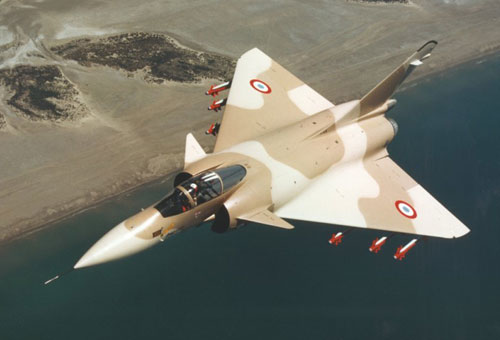Dassault Mirage 4000
Summary
| Category | Combat aircraft |
| Origin country | 🇫🇷 France |
| First flight | 9 March 1979 |
| Year of introduction | |
| Number produced | 1 units |
| Average unit price | $35 million |
Description
The Dassault Mirage 4000, sometimes referred to as the Super Mirage 4000, was a prototype twin-engine fighter aircraft developed by Dassault-Breguet as an evolution of the Mirage 2000. Considerably larger and heavier than its single-engined predecessor, the Mirage 4000 was powered by two SNECMA M53-2 turbofan engines. Financed as a private venture by Dassault, the aircraft was intended to function as both a long-range interceptor and a fighter-bomber, comparable in size to the American F-15 Eagle. The first flight occurred on March 9, 1979. The expertise gained from the Mirage 4000 project influenced the later Dassault Rafale.
The design retained the delta wing configuration and semi-conical Oswatitsch-type air intakes of its predecessor. It featured small canards positioned above the engine air intakes and incorporated a bubble canopy.
The aircraft was equipped with two 30 mm DEFA cannons, each holding 125 rounds. It featured 11 hardpoints with a total capacity exceeding 8,000 kg for various combinations of ordnance. These hardpoints could accommodate up to three 2,500-liter drop tanks, a FLIR pod, a reconnaissance pod, a laser designator pod, and an ALTIS III targeting system. For air-to-air combat, the aircraft could carry two long-range air-to-air missiles (AAMs) and between 8 to 14 advanced AAMs. Air-to-ground capabilities included provisions for up to four air-to-ground missiles (AGMs) or up to 27 × 250 kg bombs, as well as up to four rocket pods.
The Dassault Mirage 4000 was primarily a prototype, and its operational history is limited to flight testing. Designed to be a long-range interceptor and fighter-bomber, it was never adopted by the French Air Force or any other nation. The program was discontinued in the early 1980s after potential customers like the Royal Saudi Air Force opted for the Panavia Tornado, and the Iranian Revolution in 1979 eliminated Iran as another possible buyer. The French Air Force chose to concentrate on the Mirage 2000. The sole prototype completed a total of 336 flights, with the last taking place on January 8, 1988. The prototype was later moved to the Musée de l'air et de l'espace in November 1992.
The Dassault Mirage 4000 had no official variants as only one prototype was ever produced.
Technical specifications
| Version: Mirage 4000 | |
|---|---|
| Crew | 1 pilot |
| Operational range | 2000 km (1243 mi) |
| Maximum speed | 2445 km/h (1519 mph) |
| Wing area | 72.7 m² (782.5 sqft) |
| Wingspan | 11.9 m (39.1 ft) |
| Height | 6.0 m (19.6 ft) |
| Length | 18.7 m (61.4 ft) |
| Service ceiling | 20000 m (65617 ft) |
| Empty weight | 13490 kg (29740 lbs) |
| Max. takeoff weight | 32000 kg (70548 lbs) |
| Climb rate | 305.0 m/s (1000.7 ft/s) |
| Powerplant | 2 × turbojets SNECMA M53-2 delivering 5550 kgp, up to 8500 kgp with afterburner |
| Ejection seat | Martin-Baker Mk 10 |
Current operating countries
No country is operating the Mirage 4000 in 2025.
All operators
Photo of Mirage 4000
